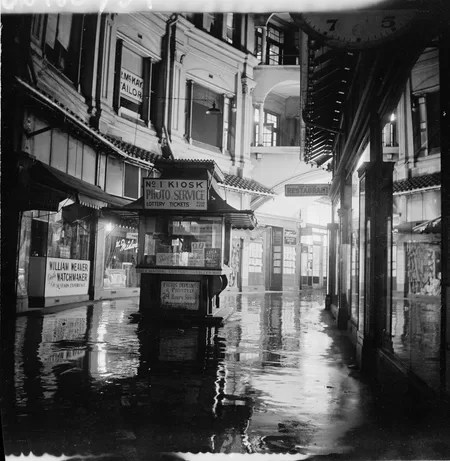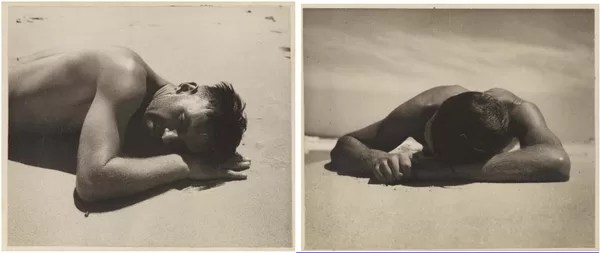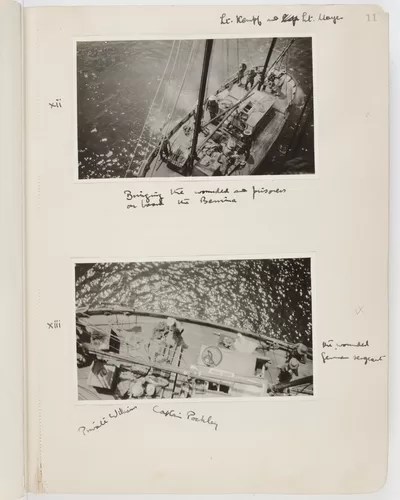The new Photography Gallery at the State Library of New South Wales opened with an exhibition called “Shot” which featured 400 photographs by 200 photographers over 3 centuries. This page chronicles the photographs in the SLNSW’s extensive photographic collection from the first half of the 20th Century.
Frank Fahy mugshots
An intriguing find in the extensive photo archives of the SLNSW is a book of mugshots (1924–1950s) captured by Sydney’s first official undercover police officer, Frank Fahy, known as ‘the Shadow.’

Frank Fahy was a legendary policeman and a master of disguise and improvisation. He had a ‘double sided’ suit made, one side was blue, the other side was grey. If a target got suspicious he would turn the suit inside out to avoid suspicion.
He also built a motorbike with a sidecar disguised as a knife sharpening business, and would sit in the box side car, watching and photographing his prey.
Francis (Frank) Maurice Fahy (1897-1978), known as ‘The Shadow,’ was among Sydney’s initial and highly effective covert law enforcement agents. His tenure spanned from the 1920s until his retirement three decades later. The restricted access to his scrapbook at the Library of NSW continues due to the sensitive content it contains.

Photo kiosk, 1949 by Brian Bird
Royal Arcade at night, Feb 1949, from Series 02: Sydney people & streets, 1948-1950, photographed by Brian Bird.
We couldn’t find many details of Brian Bird, other than he photographed Sydney life for Vogue magazine, and the State Library, amongst others.
Kings Cross, 1947 by Ray Olsen
Photojournalist Ray Olsen worked for the Sunday Sun and Pix magazine in Sydney. Pix was an Australian pictorial magazine that enjoyed a weekly run from 1938 to 1972. It was published by Associated Newspapers Limited in Sydney, Australia.

This publication stood out for its cheeky and unconventional content, its keen exploration of Australian lifestyle and popular culture, and its regular feature of pin-up style photographs showcasing Australian women.
Pix offered a unique blend of distinctly Australian elements, encompassing scandal, sensationalism, human-interest narratives, fashion, politics, scientific advancements, popular culture, and entertainment.
Pix Magazine merged with People magazine in 1972 to become Pix People. During this period, Associated Newspapers had been acquired by Fairfax Magazines in the 1950s, and later, ACP Magazines Ltd (formerly Australian Consolidated Press) in 1987.

In 2008, the ACP photo archive, which included the negatives for Pix magazine, was generously donated to the State Library.
Linda Malden, 1944 by Norman Herfort
In 1944, Australia found itself in the midst of war, and a young 23-year-old named Linda Malden was shouldering the responsibilities of overseeing her aging parents’ extensive 2,200-acre property.
She undertook tasks that had traditionally been the domain of men, including ploughing, drilling, harvesting, and droving.
In addition, she skillfully managed the slaughtering and preparation of mutton for meals and tended to the household garden.
The photograph by Norman Herfort for ACP Magazines Ltd captures a moment of respite for Linda as she pauses from her demanding labor to oil the windmill.
A flipped version of this photo appeared in a feature story in Pix Magazine, 10 May 1947.
Smithy’s Lockheed Altair, Sydney, 1934 by Sam Hood

Charles Kingsford Smith imported this aircraft for the 1934 Centenary Air Race, originally christened ANZAC. However, the use of this name was legally protected, and despite Smithy’s own service at Gallipoli, he had to change the aircraft’s name. He complied, renaming it Lady Southern Cross as a tribute to his wife.
Tragically, this is the same aircraft in which Kingsford Smith would meet his untimely end just a little over a year later.
Samuel John Hood (20 August 1872 – 8 June 1953) was an Australian photographer and photojournalist whose career extended from the 1880s to the 1950s. Hood established a Sydney photography studio specialising in portraiture and weddings in 1899.
In 1918, Hood expanded his business into press photography. He provided photographs for numerous publications, including The Sydney Mail, The Australasian, the Daily Guardian, the Daily Telegraph Pictorial, the Labor Daily, The Sun, the Daily News, and The Sydney Morning Herald.
Over time, press photography became the primary focus of his work. Sam Hood is recognized as a pioneer in this genre, becoming skilled at capturing sensational, mundane, and especially sporting moments with his camera.
During the mid-1930s, most newspapers employed their in-house photographers, causing Hood’s commissions to decline. He sought alternative types of work and secured several long-term advertising and commercial contracts. He had extensive connections in the entertainment industry, leading to requests for documenting celebrity events, stars, and theatre advertisements.
The Sunbaker, Culburra Beach, NSW, 1937 by Max Dupain
A contact print from the original negative of Max Dupain’s famous photograph the Sunbaker.

Max Dupain’s Sunbaker is Australia’s best known photograph. In 1937, Max Dupain captured a photograph of his English friend, Harold Salvage, in a head-and-shoulders portrait as he lay on the sands of Culburra Beach on the south coast of New South Wales.
It wasn’t until the 1970s that this photograph began to gain widespread recognition. In 1976, the National Gallery of Australia in Canberra acquired a print of the photograph, and by the 1990s, it had firmly established itself as an iconic representation of Australia.
An early vintage print of the original Sunbaker image is preserved in a photo album, below, which was generously donated to the State Library of New South Wales by Dupain’s friend, the architect Chris Vandyke.
The first Sunbaker had his hands clasped together and was published just once in 1948 in Hal Missingham’s Max Dupain: photographs. But all known prints, which were made between 1975 and 1991 (when the image became popular) were taken from the second negative, showing the Sunbaker’s right hand relaxed.

We’re note sure if these two photos are included in the “Shots” exhibition but we’re included them for illustrative purposes. Also in the hands of the SLNSW are the original prints from an album, curated by Max Dupain’s close friend, the architect Chris Vandyke, which comprises 108 original photographs captured by both Dupain and his future spouse, Olive Cotton. These photographs encompass portraits of the couple, their circle of friends, lighthearted camping scenes, and scenic vistas of the Culburra Beach vicinity.
Fashion shoot, Cronulla, Sydney, 1937 by Olive Cotton

Olive Cotton, born on 11 July 1911 and passing away on 27 September 2003, was an Australian photographer who transitioned from pictorialism to modernism and worked in Sydney during the 1930s and 1940s.
Her photographic talents were widely acknowledged and considered on par with those of her first husband, the renowned photographer Max Dupain, who is also featured at the Photography: Real & Imagined exhibition at National Gallery of Victoria in 2023.
Olive Cotton and Max Dupain formed an Australian photographic duo reminiscent of famous international couples such as Robert Capa and Gerda Taro, Edward Weston and Margrethe Mather, Edward Weston and Tina Modotti, or Man Ray and Alice Prin (better known as Kiki de Montparnasse).
Together, they crafted bold, distinctive, and quintessentially Australian photographs during the 1930s and 1940s. Following her divorce from Dupain in the mid-1940s, Cotton relocated to Cowra with her second husband and two children, settling on a farm devoid of modern amenities such as running water, telephone, or electricity. She largely withdrew from the public eye.
It wasn’t until an exhibition in Sydney in 1985 and a significant retrospective at the Art Gallery of New South Wales in 2000 that her contributions to Australian photography were rediscovered and her status as one of the country’s esteemed photographers was reaffirmed.
Pearl Gibbs by an unknown photographer

Pearl Mary (Gambanyi) Gibbs, born Pearl Mary Brown on 18 July 1901 and passing away on 28 April 1983, is recognised as one the most important women activists in the 20th century.
Pearl Gibbs played a pivotal role in amending Australia’s constitution. She collaborated with fellow activists Jessie Street and Faith Bandler in a ten-year campaign to advocate for the 1967 referendum. During this time, they gathered an impressive 100,000 signatures in support of the cause.
The referendum garnered an overwhelming 90.77% “yes” vote from Australians. As a result of this historic event, it marked the first formal recognition of Aboriginal and Torres Strait Islander people as members of Australia’s population.
Pearl Gibbs actively participated in the Aborigines Progressive Association (APA) and played a central role in various protest actions, including the 1938 Day of Mourning which was, at the time, the most significant Aboriginal civil rights demonstration in Australia.
Between 1954 and 1957, Gibbs held the distinction of being the sole Aboriginal member of the New South Wales Aborigines Welfare Board, and notably, she was the only woman to ever sit on the board.
Shackleton expedition, 1915 self portrait by Frank Hurley

Frank Hurley’s Paget plates represent an early incarnation of color photography. Among his most renowned works are the vivid color photographs of the ill-fated Endurance expedition.
Following the crushing of the Endurance by ice in 1915, Hurley successfully salvaged glass plates and film from the slushy waters within the shipwreck. Shackleton and Hurley selected 120 glass plates to preserve.
Regrettably, they had to break and abandon around 400 glass plates on the ice due to “owing to the very limited space that will be at disposal in boat transport” as noted in Frank Hurley’s diary on November 9, 1915. Only 17 colour images survived the wreck and 170 days of life on a drifting ice floe.
Serving as the official photographer during Sir Ernest Shackleton’s British Imperial Trans-Antarctic Expedition from 1914 to 1917, Hurley faced the harshest of environments. In his diary, he chronicled the challenges of capturing images in the Antarctic:
“Dark room work rendered extremely difficult by the low temperatures, it being -13 (-25 degrees Celsius) outside. Washing plates is a most troublesome operation, as the tank must be kept warm or the plates become an enclosure in an ice block.”
Frank Hurley’s diary, also in the State library of NSW
First losses of the First World War, 1914 by Frederick Spencer Burnell

Frederick Spencer Burnell (1 February 1880 – 10 February 1958) served as a special correspondent accompanying the Australian Naval and Military Expeditionary Force during their mission to capture and dismantle German wireless stations in German New Guinea in 1914.
This operation marked Australia’s inaugural involvement in World War I. Upon his return, Burnell authored a comprehensive account of these events, titled “How Australia took German New Guinea: an illustrated record of the Australian naval & military expeditionary force” which was published by Australasian News in Sydney in 1915.
The link above takes you to the book on Trove. The caption to the photos on the right, reads: “Bringing wounded and prisoners on board the Berrima during the fighting at Kabakaul.”
The publication featured photographs that Burnell had taken during his journey to New Guinea on the Berrima, as well as images documenting the training on Palm Island and the activities in New Britain.
The “Shots” exhibition includes gelatin silver prints in Burnell’s photo album.
Hordern’s department store, Sydney, 1901 by Arthur Ernest Foster

Arthur Ernest Foster was a commercial photographer at 289 Victoria Road, Gladesville between 1916 and 1947. Arthur Foster died, aged 79, in 1958.
Anthony Hordern & Sons stood as the largest department store in Sydney and ranked among the world’s largest.
Founded by English immigrants Anthony Hordern and his wife Ann in 1823 as a drapery shop, the family later relocated to Melbourne. In 1844, their sons, Lebbeus and Anthony, established their own drapery firm at 689 George Street, Brickfield Hill, the very site now occupied by World Square.
In 1856, a new three-story store in Haymarket was inaugurated. The department store was engulfed by a destructive fire on July 10, 1901, resulting in the tragic loss of five lives and the destruction of merchandise valued at half a million pounds. This catastrophic event prompted significant improvements in Sydney’s firefighting services and the introduction of regulations mandating the use of fire-resistant materials in the construction of new buildings.
Shots exhibition at State Library of NSW
The previous page in this series looks at some of the 19th century photographs in the exhibition.
The next page looks at the second half of the 20th century. Also included in Shots are contemporary images and commentary contributed by over 30 contemporary photographers, including Stephen Dupont, Tony Mott, and Anne Zahalka.
“Shot” is a free exhibition showcased in the State Library’s new Photography Gallery and will be open to the public until October 20, 2024. You can find more information on the SLNSW website
Related stories
State Library of NSW new Photography Gallery exhibition Shot
The first photograph taken in Australia was by Captain Lucas
The oldest surviving Daguerreotype in Australia, 1845
Australia’s first professional photographer George B Goodman
10 important photography exhibitions in Australia
Louis Daguerre and the invention of the daguerreotype
The beginning of photography: heliographs and daguerreotypes
Photography: Real & Imagined at National Gallery of Victoria




